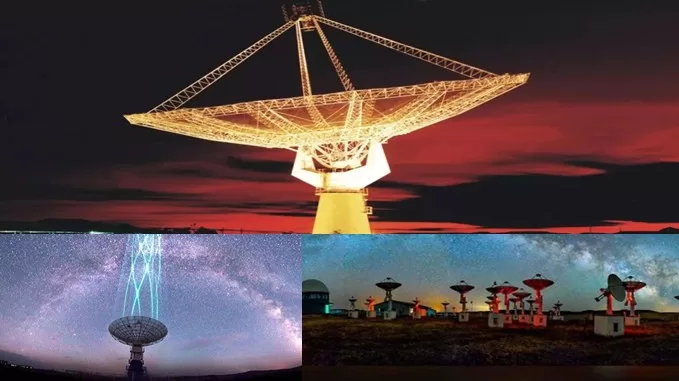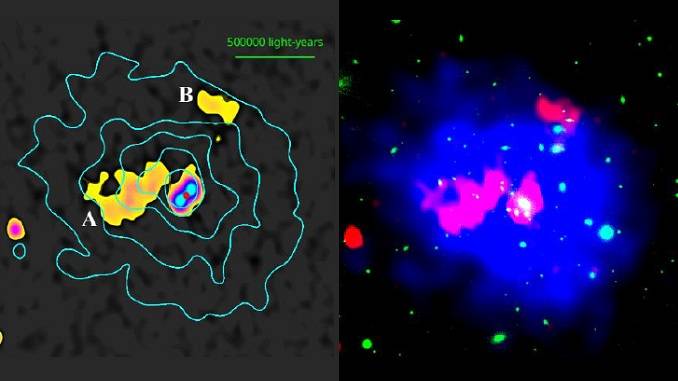
GMRT received a radio signal 8.8 billion light-years away from Earth
Astronomers detected a record-breaking radio frequency signal from 8.8 billion light years away from Earth, that is received by the Giant Metrewave Radio Telescope (GMRT) in India.
Astronomers have received the most distant signal of its kind from a remote galaxy using warped space-time as a magnifying glass. Using a cosmic trick first predicted by Einstein, astronomers detected this radio signal from deeper in space than ever before.
The secrets of the universe’s ‘dark age‘ may be revealed by this radio signal coming from 8.8 billion light-years away, and it may provide an insight into how our universe formed.
The record-breaking radio frequency signal, received by India’s Giant Metrewave Radio Telescope (GMRT), came from the ‘Galaxy SDSSJ0826+5630’, which is located 8.8 billion light-years from Earth. This means that the signal was emitted when the universe was nearly a third of its present age.
The signal is an emission line from neutral hydrogen, the most primordial element of the universe. This element existed throughout the cosmos as a turbulent fog following the Big Bang, from which the first stars and galaxies eventually formed.
For a very long time, astronomers have searched for distant signals from neutral hydrogen in the hope of finding the moment the first stars start to shine. However, these signals were difficult to spot due to the extreme distances involved.
Now, a new study suggests that an effect known as gravitational lensing could aid astronomers in finding evidence of neutral hydrogen. This research was published on Dec. 23 in the journal Monthly Notices of the Royal Astronomical Society.
“A galaxy emits different kinds of radio signals,” study lead author Arnab Chakraborty, a cosmologist at McGill University in Canada, stated in a statement. “Until now, it’s only been possible to capture this particular signal from a galaxy nearby, limiting our knowledge to those galaxies closer to Earth.”
The ‘Dark age’ of the Universe –
Around 400,000 years after the universe’s beginning when protons and electrons first bonded to neutrons, neutral hydrogen occupied the dim early cosmos during its so-called dark age — an era before the first stars and galaxies came into existence.
When stars do eventually form, they blast out fierce ultraviolet light that strips the electrons from many of the hydrogen atoms in the space around them, thus ionizing the atoms so they’re no longer neutral. Lastly, some of the ionized atoms recombine into neutral hydrogen as young stars lose their UV intensity.
The discovery and study of neutral hydrogen can provide insight into the early stars’ lives as well as the time before the existence of stars. Neutral hydrogen emits light at a characteristic wavelength of 21 cm. Until now, the farthest 21 cm hydrogen signal that has been detected is 4.4 billion light-years away.
However, it is challenging to use neutral-hydrogen signals to study the early cosmos because the long-wavelength, low-intensity waves often get drowned out across huge cosmic distances.
Read Also – GMRT discovers the oldest known fossil radio galaxy trapped inside a cluster of galaxies
By using Gravitational Lensing, we can look into the past.
To find a signal at a distance twice the prior distance, the researchers used an effect known as gravitational lensing.
Albert Einstein explained in his theory of general relativity that gravity is actually our experience of space-time curving and distorting in the presence of matter and energy rather than produced by an unseen force. Gravitational lensing occurs when a massive object comes between our telescopes and its source.
In this case, the space-warping object was the gigantic star-forming galaxy SDSSJ0826+5630. It used its enormous warping effect to function as a lens that steered a dim and distant neutral hydrogen signal into focus for the GMRT.
“In this specific case, the signal is bent by the presence of another massive body, another galaxy, between the target and the observer,” stated Nirupam Roy, a co-author of the study and an associate professor of physics at the Indian Institute of Science. “This effectively results in the magnification of the signal by a factor of 30, allowing the telescope to pick it up.”
Now that scientists have discovered a method of probing previously unreachable hydrogen clouds, they intend to utilize it to enhance the charting of the universe throughout its various cosmological ages and, hopefully, identify the precise time the first stars began to shine.
Copyrighted Material © 2019 - 2024 Prinsli.com - All rights reserved
All content on this website is copyrighted. It is prohibited to copy, publish or distribute the content and images of this website through any website, book, newspaper, software, videos, YouTube Channel or any other medium without written permission. You are not authorized to alter, obscure or remove any proprietary information, copyright or logo from this Website in any way. If any of these rules are violated, it will be strongly protested and legal action will be taken.





Be the first to comment